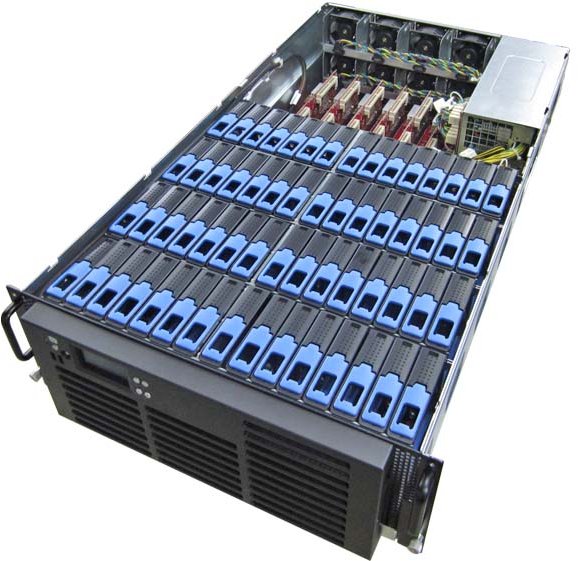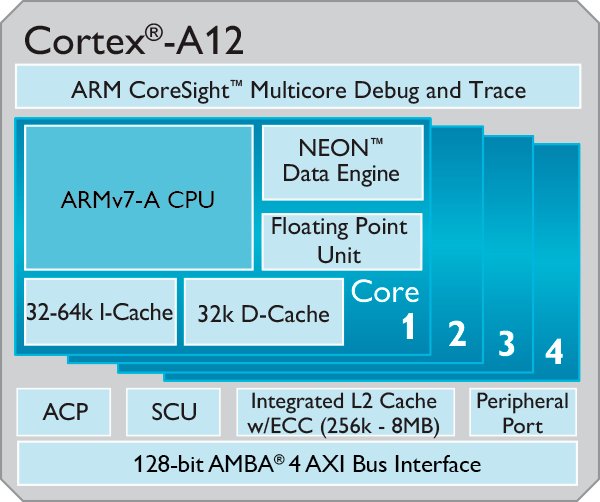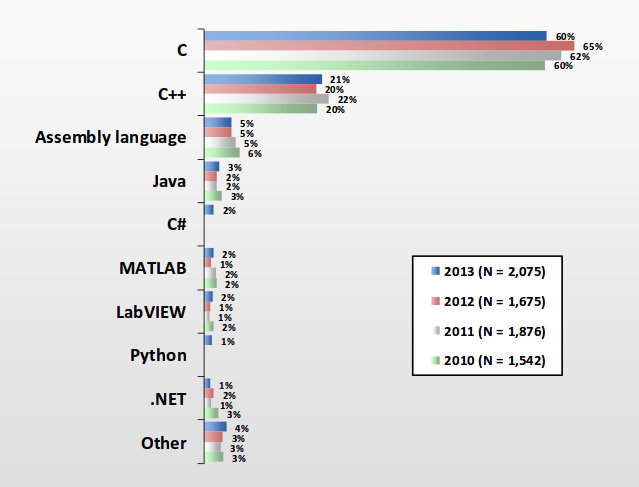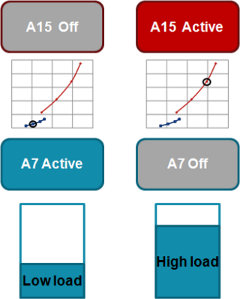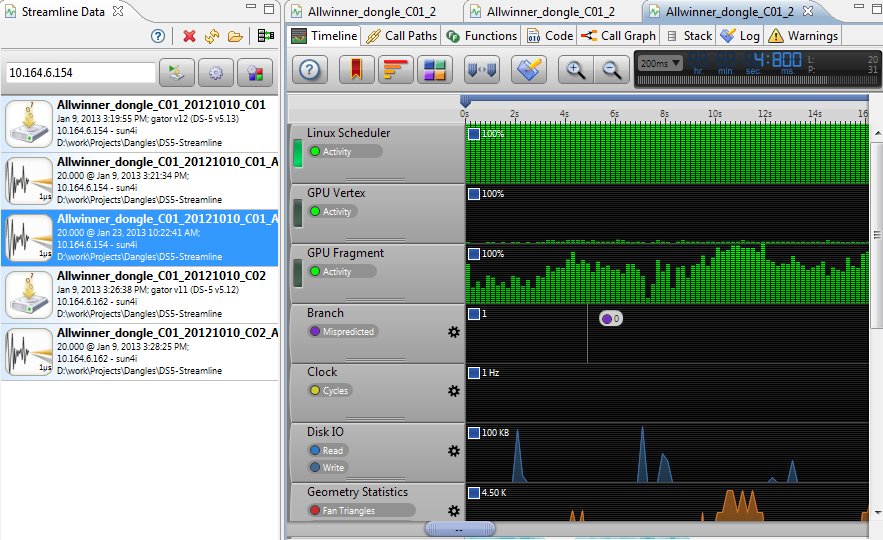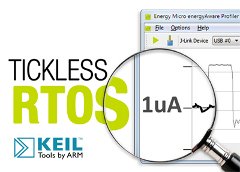ARM started to get involved in servers in 2011 with the announcements of Calxeda Energy Core, Marvell, and Applied Micro X-Gene Servers-on-a-Chip, and in 2012, products made by companies such as HP and Mitac started to appears. We’ve got to see some more ARM based servers this year thanks to Charbax, who filmed some Aaeon and Foxconn servers powered by Calxeda EnergyCore quad core ARM Cortex A9 SoC at Computex 2013. The first server is Aaeon Indus 1U cloud storage appliance: 1U Chassis 2x Calxeda Energycore nodes 10x 3.5″ HDD 2x 10 GbE uplinks and 4x 10GbE chassis-to-chassis interconnects Foxconn server shown at Computex has slightly higher specs: 4U chassis 12 Calxeda Energycore nodes 60x 3.5″ HDD for up to 240TB storage 4x 10 GbE uplinks and 6x 10 GbE chassis-to-chassis interconnects for 100 GbE total bandwidth There’s also a Gigabyte server, but I could get details. Server based on […]
ARM Announces Cortex-A12 processor, Mali-T622 GPU and Mali-V500 VPU
Right before Computer 2013, ARM has made a single announcement for 4 new products for smartphones: Cortex A12 core, Mali-T622 GPU, Mali-V500 video processor unit, and POP IP technology. Cortex A12 processor, with 40 percent more performance than Cortex-A9, positions itself between Cortex A9 and A15 offerings, and brings virtualization, big.LITTLE processing, and up to 1TB addressable memory to mid-range devices. Combined with the new Mali-T622 GPU, it will offer GPU Compute and OpenGL 3.0 solution. Add the new Mali-V500 video IP solution to complete the SoC for tomorrow’s, 2015 more exactly, mid-range smartphones and tablets between $200 and $350. Cortex A12 will have the following key features: Architecture – ARMv7-A Cortex Multicore – 1-4X SMP within a single processor cluster Multiple coherent processor clusters through AMBA 4 technology Support ARM Thumb-2 TrustZone security technology NEON Advanced SIMD DSP & SIMD extensions VFPv4 Floating point Hardware virtualization support Large Physical […]
2013 Embedded Market Study – Software Development & Processors
UBM releases a study of the embedded market every year, by surveying over 1,000 embedded professional every year. They’ve just published their 2013 Embedded Market Study (85 pages report), after surveying over 2,000 engineers and managers, so let’s see whether anything has evolved in the software development and processor space compared to 2012. Again this year, most respondents are based in the US (62%), followed by Europe (20%), and Asia (12%). C/C++ languages still rule the embedded world with 81% market share, although a little less than last year (85%), assembler is a distant third (5%). Interestingly, the average size of development teams seems to have shrunk from 15.9 in 2012 to 14.6 in 2013, the average project being composed of 4 software engineers, 2.9 hardware engineers, 2.7 firmware engineers, 2 QA/Test engineers, 1.5 system integrators, and 1.5 with other functions. About a third of project last less than 6 […]
Linaro Releases IKS big.LITTLE Implementation Source Code
Yesterday, Linaro announced the released of the IKS (In-kernel switcher) implementation for big.LITTLE processor which allows the SoC to switch between individual Cortex A7 or Cortex A15 cores to optimize power consumption. Currently, the only consumer device using supporting big.LITTLE the Samsung Galaxy S4 thanks to Samsung Exynos 5 Octa featuring 4 ARM Cortex A7 and 4 ARM Cortex A15 cores. IKS implementation can only make use of 4 cores at a time in this processor, since it must choose between A7 or A15 depending on the load. HMP (Heteregenous Multi-Processing) implementation is currently worked on in order to be able to use all 8 cores, and distributes tasks to the right core for the job. You can read my previous post for differences between IKS and HMP. Linaro explains the current source still needs a few more modifications before being upstream to mainline. The code was developed for and […]
Linux 3.9 Release
Linus Torvalds has announced the release of Linux Kernel 3.9: So the last week was much quieter than the preceding ones, which makes me suspect that one reason -rc7 was bigger than I liked was that people were gaming the system and had timed some of their pull requests for just before the release, explaining why -rc7 was big enough that I didn’t actually want to do a final release last week. Please don’t do that. Anyway. Whatever the reason, this week has been very quiet, which makes me much more comfortable doing the final 3.9 release, so I guess the last -rc8 ended up working. Because not only aren’t there very many commits here, even the ones that made it really are tiny and not pretty obscure and not very interesting. Also, this obviously means that the merge window is open. I won’t be merging anything today, but if […]
Using ARM Development Studio 5 (DS-5) Streamline with MK802II mini PC
MK802-II is an Android 4.0 mini PC powered by AllWinner A10 (ARM Cortex A8) with 1GB RAM and 4GB flash. Instructions are also available to run Ubuntu, or other Linux distributions. ARM Development Studio 5 (ARM DS-5) is software development tool suite for ARM processors that can be used for both Linux and Android debugging, and available in 2 versions: professional edition and community edition, the latter being free of charge. I’m writing about both today, because Bob Peng, Technical Marking Engineer for ARM China, recently wrote a blog post in Chinese [Update: An English version is now available] showing how to use MK802-II, preloaded with the required drivers and daemon, with DS-5 Streamline Performance Analyzer with is part of both versions. The community edition may be missing some features of Streamline however. Streamline Performance Analyzer allows you to: Find out which modules or functions to take up most of […]
How to Detect if an ARM ELF Binary is Hard-float (ARMHF) or Soft-float (ARMEL)
If some cases you may want to know if a library or binary built for the ARM architecture is using hard-float (armhf) or soft-float (armel). You can analyze ELF binary using readefl utility, so let’s have a try. First let’s install some armel and armhf files on a computer running Ubuntu by install gcc/g++ toolchain for armel and armhf:
|
1 |
apt-get install g++-arm-linux-gnueabi g++-arm-linux-gnueabihf |
We now have armhf and armel libraries installed in /usr/arm-linux-gnueabihf/lib and /usr/arm-linux-gnueabi/lib respectively. Let’s check the output of readelf filtered with “FP” string for libm.so.6 for armel:
|
1 2 3 4 5 6 7 |
readelf -a /usr/arm-linux-gnueabi/lib/libm.so.6 | grep FP Tag_FP_arch: VFPv3-D16 Tag_ABI_FP_denormal: Needed Tag_ABI_FP_exceptions: Needed Tag_ABI_FP_number_model: IEEE 754 Tag_ABI_HardFP_use: SP and DP |
and armhf:
|
1 2 3 4 5 6 7 8 |
readelf -a /usr/arm-linux-gnueabihf/lib/libm.so.6 | grep FP Tag_FP_arch: VFPv3-D16 Tag_ABI_FP_denormal: Needed Tag_ABI_FP_exceptions: Needed Tag_ABI_FP_number_model: IEEE 754 Tag_ABI_HardFP_use: SP and DP Tag_ABI_VFP_args: VFP registers |
Great, so there’s an extra line for armhf (Tag_ABI_VFP_args) that seems to confirm the library is hard-float. With readelf compiled from elftoolchain-0.6.1 (source code), the extra line will be a bit different: “Tag_ABI_VFP_args: AAPCS (VFP variant) AAPCS stands for ARM Architecture Procedure Call Standard. You can read more details on ARM website. There are also two other possible values […]
Keil RTX RTOS is Now Available for Energy Micro EFM32 MCUs
Energy Micro has recently announced the availability of the Keil RTX real-time operating system (RTOS) as part of its Simplicity Studio tool suite. The Keil RTX has been optimized for ARM Cortex-M processors to provide flexible scheduling and high-speed operation, and has been improved to enable an ultra-low power, deep-sleep mode between tasks. Energy Micro has implemented a tickless mode in Keil RTX. This mode allows the EFM32 Cortex M3 MCUs to wake up only when needed, either at a scheduled time or on an interrupt event. This results in much lower power consumption in sleep mode compared to other SysTick implementations. The video below shows the difference between SYSTICK mode where the system consumes about 2.7mA in active mode, and 830 uA in sleep mode to the new tickless mode where the MCU still consume the same amount of energy in Active mode, but only 1uA in sleep mode, […]


